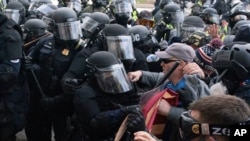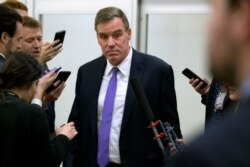The first in a series of congressional hearings on the January 6 U.S. Capitol attack has sparked a debate over whether intelligence breakdowns left the building vulnerable to what some officials and lawmakers have termed a “planned and coordinated” insurrection by supporters of former President Donald Trump.
Former officials responsible for Capitol security appeared before two Senate panels on Tuesday to defend their actions in the lead-up to and during the bloody riot that left five dead and hundreds injured, saying they did everything they could to prepare for the attack and that the intelligence community failed to see it coming.
But some experts say blaming the riot solely on faulty intelligence is misplaced.
"It was very much of a collective failure, much like one could argue that September 11, 2001, was a collective failure in response or anticipation,” said Bruce Hoffman, a veteran terrorism expert at the Council on Foreign Relations.
Intelligence failure?
The claim that the FBI and other agencies failed to predict the attack came from Robert J. Contee III, current chief of the Metropolitan Police Department, and Steven Sund, former chief of the U.S. Capitol Police (USCP), the 2,000-plus-strong force tasked with protecting the Capitol and surrounding government buildings.
Sund told lawmakers that while Capitol Police had prepared for a large, potentially violent protest, it received no intelligence from the FBI or other agencies indicating that a planned takeover of the Capitol was in the works — one designed to prevent House and Senate lawmakers from certifying Democrat Joe Biden’s victory over Trump in the November 3 presidential election.
“Without the intelligence to properly prepare, the USCP was significantly outnumbered and left to defend the Capitol against an extremely violent mob,” Sund said.
Based on its own intelligence assessments, the Capitol Police believed the January 6 event would be “similar” to two previous pro-Trump rallies in Washington in November and December, and police officials took what they considered to be appropriate actions.
But Hoffman said there was plenty of open and clandestine social media chatter prior to January 6 to suggest it “would likely be very different from all previous protests as a last and final opportunity to contest and disrupt the 2020 presidential election.”
A lack of good intelligence before January 6 was not an issue, Hoffman said. As The Washington Post reported, Hoffman noted, the Capitol Police’s own intelligence unit warned in a 12-page January 3 memo that “Congress itself” could be targeted by pro-Trump protesters as “the last opportunity to overturn the results of the presidential election.”
"I don't know how much more explicit one can get," Hoffman said in an interview.
What did agencies know, and when?
What the FBI and other intelligence agencies knew in advance of the January 6 attack and whether they took the right steps to warn other law enforcement agencies remain hotly debated.
The FBI and the Department of Homeland Security collect intelligence on domestic threats and routinely share their assessments with other law enforcement agencies around the country.
Democratic Senator Mark Warner, chairman of the Senate Intelligence Committee and a member of a panel in charge of Capitol security, recalled calling FBI Director Christopher Wray on January 4 to express concern about potential violence, and having a number of conversations with other top FBI officials on January 5 and 6.
“I felt like the FBI felt that they were in better shape in terms of intel and preparation than what came to be the case,” Warner said.
But while FBI officials apparently knew of no looming attack on the Capitol by radical groups and ardent Trump supporters, the bureau, in the late hours of January 5, warned law enforcement agencies around the country about online calls for violence that would begin the next day in Washington.
Prepared by the FBI’s Norfolk, Virginia, office, the “raw intelligence” report cited an online thread of extremists that stated, “Be ready to fight. Congress needs to hear glass breaking, doors being kicked in. … Get violent. Stop calling this a march, or rally or a protest. Go there ready for war.”
In a statement issued late Tuesday, the FBI said, “The language was aspirational in nature with no specific and credible details.”
Such “aspirational” threats are often vague in nature and cannot be traced to a specific individual or group, according to security experts.
With the rise in recent years of far-right extremism, determining what threat is aspirational and what is more serious has become all the more challenging for law enforcement agencies, said Colin Clarke of the Soufan Group, a nonpartisan global security research consultancy.
"We're dealing with a much, much bigger — in aggregate — mass of people than we would have been even a year or two ago,” Clarke said.
Top officials overlooked
The January 5 FBI memo was shared widely with law enforcement but failed to reach the top officials at the Capitol Police and Metropolitan Police Department, raising questions about a breakdown in intelligence-sharing.
Sund said the report was sent through a joint terrorism task force to a Capitol Police sergeant but was not pushed up the chain of command.
Lawmakers questioned why such vital information was not flagged to top officials. Senator Amy Klobuchar, chairwoman of the Senate Committee on Rules and Administration, said the fact that the report did not reach top leaders “is very disturbing on both ends.”
"You can't just push ‘send’ on an email” without following up on it and raising concerns at the highest levels, she said.
In a statement, the FBI defended its handling of the intelligence. It said it shared the memo with its law enforcement partners within 40 minutes of receiving it. In addition, the report “was also posted on the Law Enforcement Enterprise Portal (LEEP), which is available to law enforcement officers nationwide,” the bureau said.













